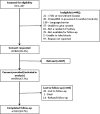Ischaemic heart disease, influenza and influenza vaccination: a prospective case control study
- PMID: 23966030
- PMCID: PMC3841753
- DOI: 10.1136/heartjnl-2013-304320
Ischaemic heart disease, influenza and influenza vaccination: a prospective case control study
Abstract
Background: Abundant, indirect epidemiological evidence indicates that influenza contributes to all-cause mortality and cardiovascular hospitalisations with studies showing increases in acute myocardial infarction (AMI) and death during the influenza season.
Objective: To investigate whether influenza is a significant and unrecognised underlying precipitant of AMI.
Design: Case-control study.
Setting: Tertiary referral hospital in Sydney, Australia, during 2008 to 2010.
Patients: Cases were inpatients with AMI and controls were outpatients without AMI at a hospital in Sydney, Australia.
Main outcome measures: Primary outcome was laboratory evidence of influenza. Secondary outcome was baseline self-reported acute respiratory tract infection.
Results: Of 559 participants, 34/275 (12.4%) cases and 19/284 (6.7%) controls had influenza (OR 1.97, 95% CI 1.09 to 3.54); half were vaccinated. None were recognised as having influenza during their clinical encounter. After adjustment, influenza infection was no longer a significant predictor of recent AMI. However, influenza vaccination was significantly protective (OR 0.55, 95% CI 0.35 to 0.85), with a vaccine effectiveness of 45% (95% CI 15% to 65%).
Conclusions: Recent influenza infection was an unrecognised comorbidity in almost 10% of hospital patients. Influenza did not predict AMI, but vaccination was significantly protective but underused. The potential population health impact of influenza vaccination, particularly in the age group 50-64 years, who are at risk for AMI but not targeted for vaccination, should be further explored. Our data should inform vaccination policy and cardiologists should be aware of missed opportunities to vaccinate individuals with ischaemic heart disease against influenza.
Keywords: Coronary Artery Disease; Infection.
Figures
Comment in
-
Ischaemic heart disease, influenza and influenza vaccination: a prospective case control study.Heart. 2014 Mar;100(6):517-8. doi: 10.1136/heartjnl-2013-305406. Epub 2014 Jan 16. Heart. 2014. PMID: 24436221 Free PMC article. No abstract available.
References
-
- Chiu C, Dey A, Wang H, et al. Vaccine preventable diseases in Australia, 2005 to 2007. Commun Dis Intell 2010;34(Supp):S1–167 - PubMed
-
- Fiore AE, Uyeki TM, Broder K, et al. Prevention and control of influenza with vaccines: recommendations of the Advisory Committee on Immunization Practices (ACIP), 2010. MMWR Recomm Rep 2010;59:1–62 - PubMed
-
- Reichert TA, Simonsen L, Sharma A, et al. Influenza and the winter increase in mortality in the United States, 1959–1999. Am J Epidemiol 2004;160:492–502 - PubMed
Publication types
MeSH terms
Substances
LinkOut - more resources
Full Text Sources
Other Literature Sources
Medical

